Colombia’s extraordinary variety of habitats—Andean cordilleras, Amazonian rainforest, cloud forests, Llanos savannas, and two coasts—has produced a wealth of local wildlife. Below is a field-ready guide to 23 endemic or highly localized Colombian species (with a few from adjacent regions), spanning mammals, birds, reptiles, and amphibians.

Scientific name: Bassaricyon neblina · Group: Mammal (Procyonidae)
Range & habitat: Cloud forests of Colombia and Ecuador; cool, wet, mid- to high-elevation forests.
Size & look: ~900 g; big dark eyes; plush coat; nocturnal and strongly arboreal.
Diet & behavior: Primarily frugivorous, also nectar and insects; mostly solitary with small home ranges.
Conservation notes: Cloud-forest fragmentation and illegal pet trade are the key concerns.
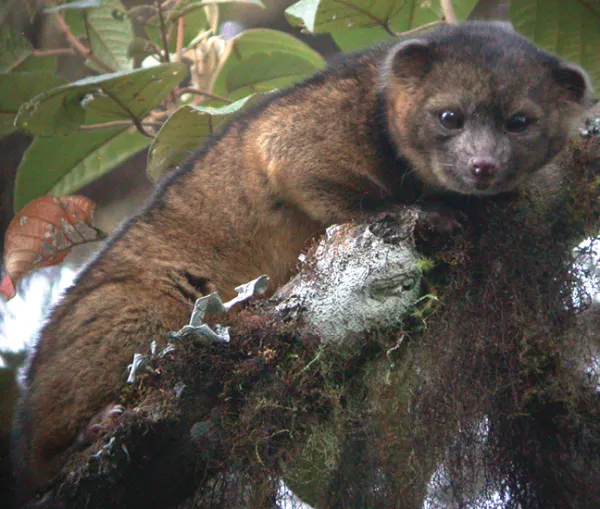
Scientific name: Ateles fusciceps rufiventris · Group: Mammal (Atelidae)
Range & habitat: Humid forests, cloud forests, and seasonal dry forests in Colombia; up to >2,000 m.
ID tips: Long limbs, thumb-less hands, and a prehensile tail with a bare tactile patch unique to each individual; up to ~9 kg.
Social system: Large communities (≈ 30), often foraging as 3–4-member subgroups.
Diet: Fruit-dominated, with seeds, bark, leaves, flowers, and insects.
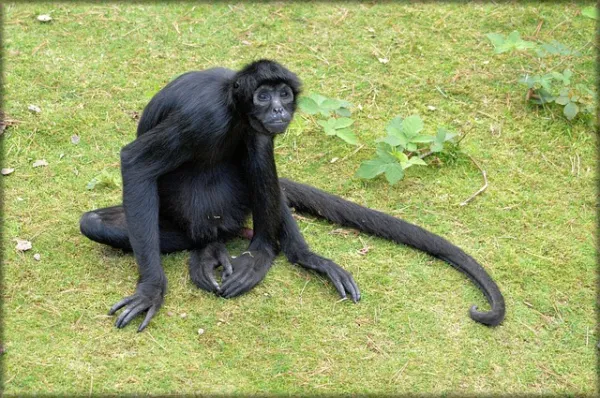
Scientific name: Chelonoidis carbonaria · Group: Reptile (Testudinidae)
Range & habitat: Tropical rainforests, savannas, and grasslands across northern South America, widespread in Colombia.
ID tips: Dark carapace with orange-red spots; head and limbs also show orange markings; 30–35 cm; males larger.
Activity & diet: Diurnal; mainly herbivorous (leaves, fruit, fungi), will take invertebrates and carrion.
Threats: Overharvest for meat, habitat loss, and pet trade.
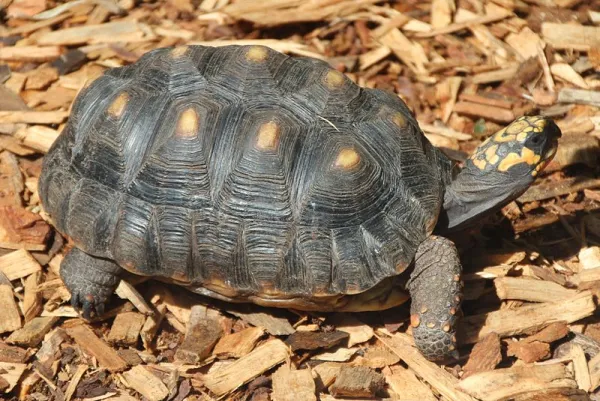
Scientific name: Anolis gorgonae · Group: Reptile (Dactyloidae)
Range & habitat: Endemic to Gorgona Island (Colombia), on rainforest trunks.
ID tips: Striking blue body; small, insectivorous.
Status & threats: Endangered due to deforestation and predation/competition from the introduced basilisk (Basiliscus galeritus).
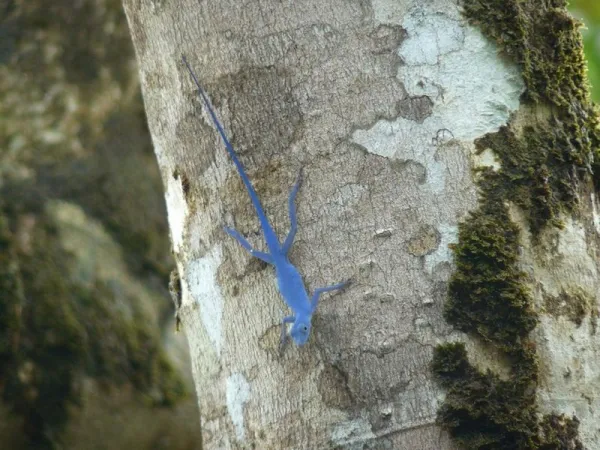
Scientific name: Callicebus ornatus (often placed in Plecturocebus) · Group: Mammal (Pitheciidae)
Range & habitat: Moist forests in western Meta Department, Colombia.
ID tips: Distinct white hands and feet (glove-like look); soft, plush fur; ~1 kg.
Behavior: Monogamous family units (typically 2–4 animals; parents + 1–2 young); agile long-distance leapers; loud territorial duets; frequent allogrooming.
IUCN: Vulnerable (VU)—habitat loss and fragmentation.
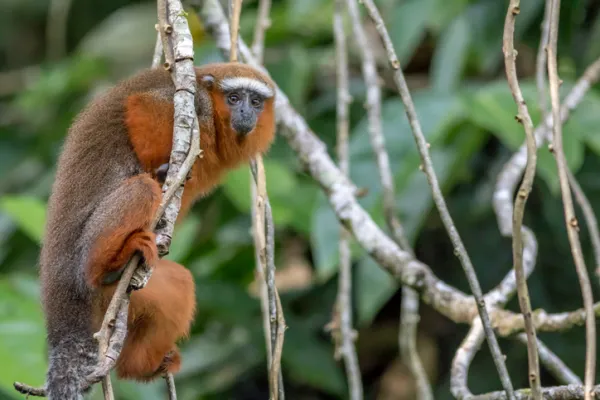
Scientific name: Vultur gryphus · Group: Bird (Cathartidae)
Range & habitat: High Andes cliffs and canyons across several countries, including Colombia.
Record-holder: Largest soaring non-marine bird—wingspan up to ~3.4 m; males to ~15 kg.
Ecology: Obligate scavenger; can soar for ~1 hour with little flapping; exceptional eyesight.
Threats: Persecution and feather trade; several regional populations are in decline.
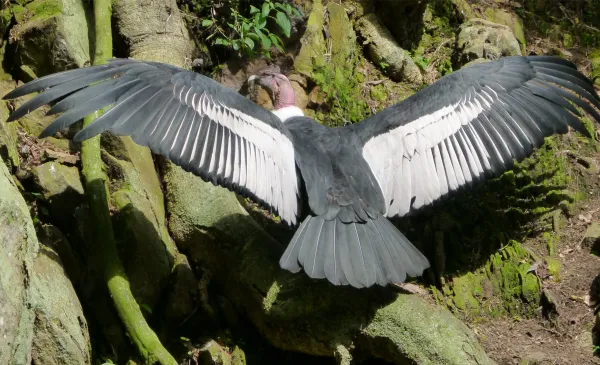
Scientific name: Tremarctos ornatus · Group: Mammal (Ursidae)
Range & habitat: Humid montane and cloud forests of the Andes.
ID tips: Pale “spectacles” around eyes (pattern is individualized); body 1.3–1.9 m, 80–125 kg; mostly black coat.
Behavior & diet: Diurnal, arboreal-capable, mostly solitary; omnivorous but largely plant-based diet.
IUCN: Vulnerable (VU).
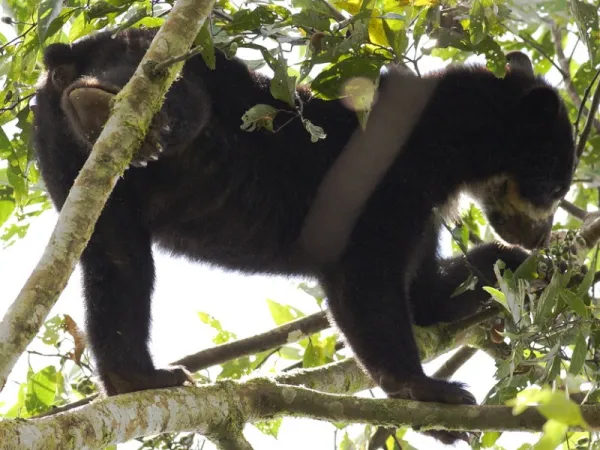
Scientific name: Coeligena prunellei · Group: Bird (Trochilidae)
Range: Endemic to the western slope of Colombia’s Eastern Cordillera.
ID tips: ~10 cm long; mostly black with small whitish side patches on the chest; blue-green iridescence on throat and shoulders.
Energy & diet: Extreme daily energy demand; nectarivorous, visiting ~2,200 flowers/day; also takes small arthropods.

Scientific name: Minyobates bombetes (often treated as Andinobates bombetes) · Group: Amphibian (Dendrobatidae)
Range: Colombian Andes—Western Cordillera (Valle del Cauca) and western slope of Central Cordillera (Risaralda, Quindío).
ID tips: Tiny—males ~17 mm, females ~18 mm; base color black/brown/purple with bright orange-red lateral stripes—classic aposematism.
Activity & status: Diurnal; Vulnerable (VU)—habitat loss and illegal pet trade.
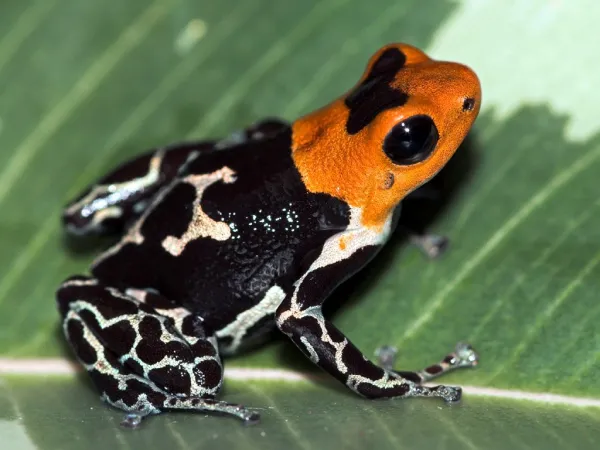
Scientific name: Diploglossus millepunctatus · Group: Reptile (Diploglossidae)
Range: Endemic to Malpelo Island, Valle del Cauca (Colombia).
Size & build: Adult ~18–36 cm total length; short-limbed, robust.
Diet: Voracious generalist predator/scavenger—insects, shore crabs, worms, even feathers and organic detritus.
Regeneration: Can autotomize and regrow the tail; notably, teeth can also regenerate.

Sword-billed Hummingbird (Ensifera ensifera): extraordinary hyper-elongated bill co-evolved with deep tubular flowers.
Sapphire-vented / Ciénaga Hummingbird (Lepidopyga lilliae): a narrow-range wetland specialist tied to specific flowering plants.
Colombian Freshwater Crab — Hypolobocera gorgonensis
Malpelo Land Crab — Johngarthia malpilensis
Gorgona Island Scorpion — Ananteris gorgonae
Colombian Leaf-toed Gecko — Phyllodactylus transversalis
Malpelo Anole — Dactyloa agassizi
Blue-billed Curassow (Paujil) — Crax alberti
Yellow-headed Brush-finch — Atlapetes flaviceps
Harlequin Poison Frog (“Cocoi”) — Oophaga histrionica
Golden Poison Frog — Phyllobates terribilis
Gray-necked Spiny Rat — Proechimys canicollis
Cotton-top Tamarin — Saguinus oedipus
Many of these are narrow-ranged and highly sensitive to forest connectivity, clean freshwater, and low disturbance. Deforestation, mining, roads, and illegal wildlife trade recur as primary pressures.
Though not strictly Colombian-exclusive, the Andean Condor is a national symbol and a keystone scavenger that helps remove carcasses and curb disease. Protecting cliff nesting sites, soaring corridors, and reducing persecution remain top priorities.
From cloud-forest canopies to oceanic islets, Colombia’s endemics showcase spectacular adaptive radiation—flower–hummingbird coevolution, chemical defense in poison frogs, fission–fusion foraging in tree-dwelling primates, and island reptile regeneration. These species depend on intact, connected habitats and effective control of illegal trade. Lasting protection hinges on habitat conservation, invasive-species management, long-term monitoring, and community co-management.
animal tags: endemic species of colombia
We created this article in conjunction with AI technology, then made sure it was fact-checked and edited by a Animals Top editor.